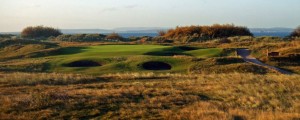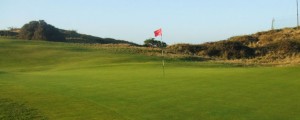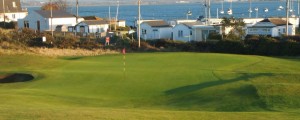Hayling Golf Club Course Review
There’s something almost nostalgic about turning into the gorse lined entrance of Hayling Golf Club. That’s not because it’s an old-fashioned club, far from it, I think it’s just to do with links golf conjuring thoughts of the game’s founding fathers, striding links courses in their buttoned tweed. That salty sea air is so evocative; the inviting wispy links grasses and windswept flags with the odd glimpse of a colourful beach hut in the distance. Links golf is hard to beat.
There’s an anticipation that builds when arriving at Hayling Golf Club. Unless you’re arriving by sea, then you’ll cross from the mainland to the island via Langstone Bridge, and begin to wind your way down to the golf club nestled in the south west corner of the island. You know it’s there, but like so many links courses, you can’t quite trust that knowledge until you see it with your own eyes as so much of the scenery on the drive feels entirely different to the linksland that awaits. Suddenly the sea appears and with it the formidable Art-Deco style clubhouse.
 In years gone by, Hayling was considered a little too far to travel for visiting golfers from London and the Home Counties, but thanks to the recent opening of the Hindhead Tunnel, the travel time heading south has been reduced dramatically. Head straight down the A3 and you can be pulling into the car park only an hour after leaving the M25. There are very few, if any, genuine links courses that can claim that proximity to London and given the quality of golf on offer and the accompanying coastal views, it’s a trip worth taking for any golfing enthusiast.
In years gone by, Hayling was considered a little too far to travel for visiting golfers from London and the Home Counties, but thanks to the recent opening of the Hindhead Tunnel, the travel time heading south has been reduced dramatically. Head straight down the A3 and you can be pulling into the car park only an hour after leaving the M25. There are very few, if any, genuine links courses that can claim that proximity to London and given the quality of golf on offer and the accompanying coastal views, it’s a trip worth taking for any golfing enthusiast.
Hayling Golf Club celebrates its 130th year in 2013. The course was originally designed by Tom Dunn, before changes were implemented by the famed JH Taylor in 1905 and then Tom Simpson in 1933. Looking to the future, Hayling is keen to maintain its position as one of the premier championship links courses in the UK & Ireland, and the club is making some subtle changes to ensure its championship status is preserved for generations to come.
It’s not just the course that is being well looked after. Hayling opened a superb new clubhouse only a decade ago that provides a magnificent setting for the members to enjoy the hospitality on offer. Of course, visitors get to enjoy it too, but it comes as no surprise to learn that the club enjoys a thriving membership. To its great credit, and not resting on its laurels, the club also has an excellent junior development program which will mean that the game of golf continues to thrive.
Playing the Course
Hayling delivers all you’d expect of a classic links course. The layout ensures the wind seems to blow from a different direction on every hole, testing your mettle and skill to the limit, while the linksland presents pancake-flat fairways one minute and tumbling humps and hollows the next. The classically-designed raised greens require imaginative bump and run shots and you’ll find the odd blind approach and tee shot, too, to ensure you’ve enjoyed the full gambit of traditional links golf before your day is through.
Front Nine
Opening with a moderately benign par 3 (unless, of course, facing a gale force wind), the course quickly disappears amid the surrounding gorse and you find yourself presented with an enticing par 5 that heads away from the clubhouse.
The first couple of holes may allow for a healthy start to your scoring, but the third offers a stern test and the first glimpse of the rolling fairways. It’s a superb dog-leg par 4 that tees off from the edge of the coast and naturally requires a strong drive. It’s also the first occasion where you may find yourself praying for one of those fortuitous bounces that only a links course can deliver.
Changing direction again, the dog-leg left fourth hole offers a generous fairway that ambles between gorse on either side before reaching the fifth, a classic links hole with a long and narrow raised green that demands attention to detail in both accuracy and distance. Anything off the green will undoubtedly leave a tricky and traditional links-style up-and-down for your par.
Playing the 3rd, 4th, and 5th gives you a quick taster of the challenge the wind direction will throw at you throughout your round. The angled holes ensure it (and you, possibly) gets flipped around, leaving you thinking very hard about your clubbing. There’s a decent chance you’ll be left scratching your head.
 If the wind doesn’t present enough of a challenge over the last three holes, it’s time for another of the elements to come in to play on the par 4 sixth, as the water flirts on more than one occasion with the fairway. I’m sure it’s wrecked many a scorecard in its time. For many it is likely to play as a par 5, but if you can make the all important carry for the second shot, it’s also the ‘make or break’ moment of the front nine.
If the wind doesn’t present enough of a challenge over the last three holes, it’s time for another of the elements to come in to play on the par 4 sixth, as the water flirts on more than one occasion with the fairway. I’m sure it’s wrecked many a scorecard in its time. For many it is likely to play as a par 5, but if you can make the all important carry for the second shot, it’s also the ‘make or break’ moment of the front nine.
Fortunately, the seventh offers immediate respite and an excellent birdie chance, as this short par 5 will be reachable for many players in two. Getting the drive away is the key here, although considering that the hole heads straight out towards the English Channel, it could well be the breeze that frustrates you this time.
The eighth serves as a reminder of Hayling’s venerable history, as this classic ‘old school’ par 4 requires a long straight drive to an undulating fairway before playing a blind approach shot over the sand dunes. Personally, I love holes like this as I think they offer a little insight into how golf courses used to be designed, while also requiring you to use your imagination. Not all will agree, but it ticked the box for me.
The ninth hole is another strong par 4, this time with a risk reward element. A semi-blind tee shot allows you to pinch the corner as much as you dare, but play too conservatively out to the right and you could run out of fairway and into trouble.
Back Nine
Starting the back nine provides cause for optimism, as an invitingly driveable par 4 welcomes you from the elevated tee. With a favourable wind the hole certainly offers a scoring chance, but to drive the small green will still require a very precise shot to be threaded up the fairway. For me, this hole starts a run through to the 13th that will compete with the best links golf you can hope to find.
The 11th is a superb short par 3 with a raised green surrounded by several pot bunkers. The next, a long par 4 that meanders up and to the right to a well protected green, before the 13th demands a brave and accurate (deceptively so) tee shot to the highest point on Hayling Island, followed by an equally well-judged approach down the dunes to a long and tricky green. Twelve and thirteen also run parallel to the shoreline, and standing at the apex of the 13th fairway affords a glorious view across the harbour to the Isle of Wight and the Solent.
 Heading for home, the fourteenth is another excellent hole, this time enticing the longer hitters into a risky carry over water for the second shot. It’s a solid par 5 that hugs a water hazard as it winds around to the left, with humps and bunkers on the approach to the green and some awkward slopes once you’ve found it. It’s a hole where par rather than birdie is a very good score.
Heading for home, the fourteenth is another excellent hole, this time enticing the longer hitters into a risky carry over water for the second shot. It’s a solid par 5 that hugs a water hazard as it winds around to the left, with humps and bunkers on the approach to the green and some awkward slopes once you’ve found it. It’s a hole where par rather than birdie is a very good score.
Fifteen is another hole that seems more formidable in retrospect than at the time. Here, any approach finishing right of the green will leave a nigh-on impossible up-and-down. You also have to negotiate a ridge running down the middle of a fairway which narrows as it approaches a couple of pot bunkers, creating a hole that deserves more caution than you initially appreciate.
Turning direction again, the mid length par 3 sixteenth is another typically demanding hole. A pot bunker devours anything that drifts to the right, and once more the challenge is simply to hit the green. And, for good measure, it’s an angled green that means gauging the wind direction correctly is even more vital to your chances of success.
The gorse seems to encroach as you thread through the final two holes, and although the fairways are generous enough on this pair of dog-leg par 4s, there’s still a fair bit of work to be done to finish the round off in style. Seventeen perhaps provides a stiffer examination than the last, where I’m sure a few birdies are yielded, but a couple of fours will certainly make the refreshments taste that much sweeter in the overlooking clubhouse.
My Verdict
So, what did I make of Hayling? Well, as I said in my opening, if you are looking for an escape from the hustle and bustle of London living, you won’t find greater escapism than taking on the challenge of a links course. There may be tougher and more visually impressive links courses in the world but some of the holes are classic, and I defy you to reach any of the world-renowned links in little over an hour from London. That’s not to belittle the course in any way – it is terrific in its own right and well worthy of its esteemed ranking , but the fact Hayling is so accessible is a valuable bonus, making a day trip from London or elsewhere in the South a very realistic proposition. There’s an atmosphere, too, which can so often be lacking and as a visitor I was made to feel very welcome. So, in short, I am a fan and I’d warmly encourage you to pop down and decide for yourself.